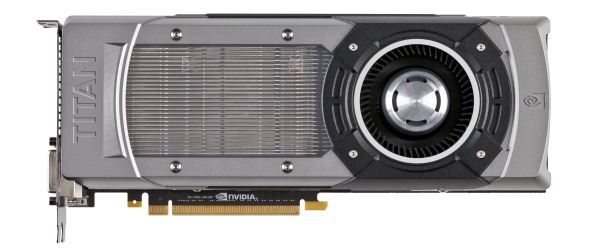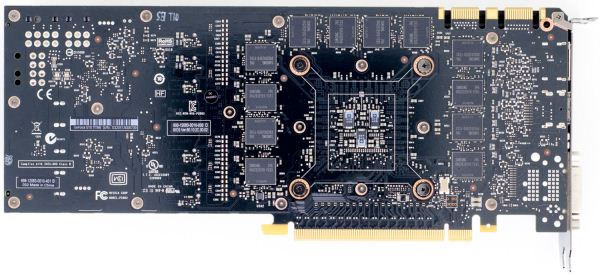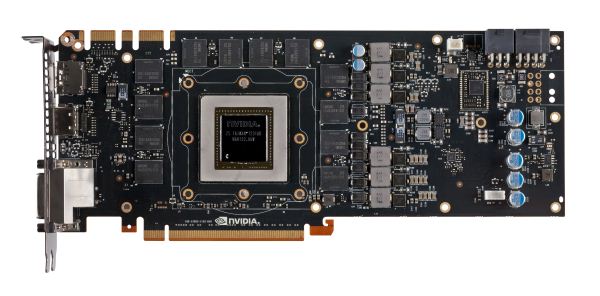NVIDIA's GeForce GTX Titan, Part 1: Titan For Gaming, Titan For Compute
by Ryan Smith on February 19, 2013 9:01 AM ESTMeet The GeForce GTX Titan
As we briefly mentioned at the beginning of this article, the GeForce GTX Titan takes a large number of cues from the GTX 690. Chief among these is that it’s a luxury card, and as such is built to similar standards as the GTX 690. Consequently, like the GTX 690, Titan is essentially in a league of its own when it comes to build quality.
Much like the GTX 690 was to the GTX 590, Titan is an evolution of the cooler found on the GTX 580. This means we’re looking at a card roughly 10.5” in length using a double-wide cooler. The basis of Titan’s cooler is a radial fan (blower) sitting towards the back of the card, with the GPU, RAM, and most of the power regulation circuitry in front of the fan. As a result the bulk of the hot air generated by Titan is blown forwards and out of the card. However it’s worth noting that unlike most other blowers technically the back side isn’t sealed, and while there is relatively little circuitry behind the fan, it would be incorrect to state that the card is fully exhausting. With that said, leaving the back side of the card open seems to be more about noise and aesthetics than it does heat management.
Like the GTX 580 but unlike the GTX 680, heat transfer is provided by a nickel tipped aluminum heatsink attached to the GPU via a vapor chamber. We typically only see vapor chambers on premium cards due to their greater costs, but also when space is at a premium. Meanwhile NVIDIA seems to be pushing the limits of heatsink size here, with the fins on Titan’s heatsink actually running beyond the base of the vapor chamber. Meanwhile providing the thermal interface between the GPU itself and the vapor chamber is a silk screened application of a high-end Shin-Etsu thermal compound; NVIDIA claims this compound offers over twice the performance of GTX 680’s grease, although of all of NVIDIA’s claims this is the least possible to validate.
Moving on, catching what the vapor chamber doesn’t cover is an aluminum baseplate that runs along the card, not only providing structural rigidity but also providing cooling for the VRMs and for the RAM on the front side of the card. Baseplates aren’t anything new for NVIDIA, but again this is something that we don’t see a lot of except on their more premium cards.
Capping off Titan we have its most visible luxury aspects. Like the GTX 690 before it, NVIDIA has replaced virtually every bit of plastic with metal for aesthetic/perceptual purposes. This time the entire shroud and fan housing is composed of casted aluminum, which NVIDIA tells us is easier to cast than the previous mix of aluminum and magnesium that the GTX 690 used. Meanwhile the polycarbonate window makes its return allowing you to see Titan’s heatsink solely for the sake of it.
As for the back side of the card, keeping with most of NVIDIA’s cards Titan runs with a bare back. The GDDR5 RAM chips don’t require any kind of additional cooling, and a metal backplate while making for a great feeling card, occupies precious space that would otherwise impede cooling in tight spaces.
Moving on, let’s talk about the electrical details of Titan’s design. Whereas GTX 680 was a 4+2 power phase design – 4 power phases for the GPU and 2 for the VRAM – Titan improves on this by moving to a 6+2 power phase design. I suspect the most hardcore of overclockers will be disappointed with Titan only having 6 phases for the GPU, but for most overclocking purposes this would seem to be enough.
Meanwhile for RAM it should come as no particular surprise that NVIDIA is once more using 6GHz RAM here. Specifically, NVIDIA is using 24 6GHz Samsung 2Gb modules here, totaling up to the 6GB of RAM we see on the card. 12 modules are on front with the other 12 modules on the rear. The overclocking headroom on 6GHz RAM seems to vary from chip to chip, so while Titan should have some memory overclocking headroom it’s hard to say just what the combination of luck and the wider 384bit memory bus will do.
Providing power for all of this is a pair of PCIe power sockets, a 6pin and an 8pin, for a combined total of 300W of capacity. With Titan only having a TDP of 250W in the first place, this leaves quite a bit of headroom before ever needing to run outside of the PCIe specification.
At the other end of Titan we can see that NVIDIA has once again gone back to their “standard” port configuration for the GeForce 600 series: two DL-DVI ports, one HDMI port, and one full-size DisplayPort. Like the rest of the 600 family, Titan can drive up to four displays so this configuration is a good match. Though I would still like to see two mini-DisplayPorts in the place of the full size DisplayPort, in order to tap the greater functionality DisplayPort offers though its port conversion mechanisms.














157 Comments
View All Comments
vacaloca - Wednesday, February 20, 2013 - link
I'm assuming TCC driver would not work stock... if it's anything like the GTX 480 that could be BIOS/softstraps modded to work as Tesla C2050, it might be possible to get the HyperQ MPI, GPU Direct RDMA, and TCC support by doing the same except with a K20 or K20X BIOS. This would probably mean that the display outputs on the Titan card would be bricked. That being said, it's not entirely trivial... see below for details:https://devtalk.nvidia.com/default/topic/489965/cu...
tjhb - Thursday, February 21, 2013 - link
That's an amazing thread. How civilised, that NVIDIA didn't nuke it.I'm only interested in what is directly supported by NVIDIA, so I'll use the new card for both display and compute.
Thanks!
Arakageeta - Wednesday, February 20, 2013 - link
Thanks! I wasn't able to find this information anywhere else.Looks like the cheapest current-gen dual-copy engine GPU out there is still the Quadro K5000 (GK104-based) for $1800. For a dual-copy engine GK110, you need to shell out $3500. That's a steep price for a small research grant!
Shadowmaster625 - Tuesday, February 19, 2013 - link
For the same price as this thing, AMD could make a 7970 with a FX8350 all on the same die. Throw in 6GB of GDDR5 and 288GB/sec memory bandwidth and a custom ITX board and you'd have a generic PC gaming "console". Why dont they just release their own "AMDStation"?Ananke - Tuesday, February 19, 2013 - link
They will. It's called SONY Play Station 4 :)da_cm - Tuesday, February 19, 2013 - link
"Altogether GK110 is a massive chip, coming in at 7.1 billion transistors, occupying 551m2 on TSMC’s 28nm process."Damn, gonna need a bigger house to fit that one in :D.
Hrel - Tuesday, February 19, 2013 - link
I've still never even seen a monitor that has a display port. Can someone please make a card with 4 HDMI port, PLEASE!Kevin G - Tuesday, February 19, 2013 - link
Odd, I have two different monitors has home and a third at work that'll accept a DP input.They do carry a bit of a premium over those with just DVI though.
jackstar7 - Tuesday, February 19, 2013 - link
Well, I've got Samsung monitors that can only do 60Hz via HDMI, but 120Hz via DP. So I'd much rather see more DisplayPort adoption.Hrel - Thursday, February 21, 2013 - link
I only ever buy monitors with HDMI on them. I think anything beyond 1080p is silly. (lack of native content) Both support WAY more than 1080p, so I see no reason to spend more. I'm sure if I bought a 2560x1440 monitor it'd have DP. But I won't ever do that. I'd buy a 19200x10800 monitor though; one day.